Last Updated on August 20, 2023 by Robert Price
Dr. O’Tar Norwood created the Norwood scale for hair loss in 1975.
Since then, thousands upon thousands of men have experienced full-on psychotic breakdowns as a result of their Norwood statuses.
I’m exaggerating, but only slightly.
Over the last few years, I’ve had many dreams about the Norwood scale.
No, not dreams.
Nightmares.
After I realized I was going bald in 2021, five years after starting this site, I discussed the scale with my therapist (just as part of an anecdote, not because I’m unstable).
Dr. Norwood’s name has even become a verb on certain hair loss forums, and many people enjoy “Norwooding” (diagnosing hair loss) in their spare time.
But this post isn’t about O’Tar Norwood, the hair loss community, or mental illness.
It’s about you.
And right now, you’re probably asking yourself this question: How bald am I?
Well, like it or not, you’re about to find out!
Below is a quick overview of the Norwood scale, which depicts the seven most commonly observed “patterns” of hair in men, plus several variations.
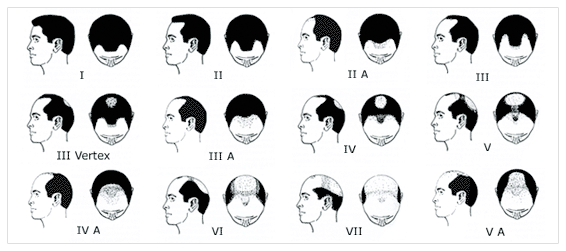
Type IIA is generally considered the first stage of balding. I’ll go over all the main classes of hair loss in this post, and give examples.
My goal here is simple: to make this the best, most in-depth, layman-friendly post on the Norwood scale on the internet. Keep in mind I’m not a doctor, but I am a hair loss researcher and consumer advocate with thousands of hours of relevant experience. And of course, you shouldn’t use this post as a guide to diagnose or treat your hair loss, if applicable. Let’s get started.
Norwood Type 0 – AKA the Ross from Friends
This isn’t even on the chart!
You rarely see grown men (Caucasians especially) with Norwood 0 hairlines. A Norwood 0 indicates no recession whatsoever and often descends slightly at the corners.
Young boys often have hairlines like this. But then again, they frequently don’t — and even children often have a tiny bit of recession along the edges of their hairlines. Some celebrities with Norwood 0 hairlines include David Schwimmer, of course, as well as Fox pundit Sean Hannity, and perhaps, Simon Cowell.
Type 1, The Juvenile Hairline, AKA the Reagan

President Reagan enjoyed a juvenile hairline for life.
Norwood one is often regarded as a “juvenile” hairline, even though it may indicate slight recession along the hairline corners; those corners often have a “rounded” appearance. Only about 5% of Caucasian men retain their juvenile hairlines throughout the course of their lifetimes.
President Reagan enjoyed a lush, full, childlike hairline into his 90s, and President Clinton is still showing off his juvenile hairline to this day, despite some reasonably mild age-related thinning. Other celebrities and noteworthy figures who have had essentially zero hair loss to this point, to my knowledge, include Anthony Bourdain of CNN (RIP), noted celebrity finasteride user Rob Lowe, Don Henley of the Eagles, Tony Danza, and Brad Pitt, to name a few.
Norwood Type 2 – The Mature Hairline

Leonardo DiCaprio at the Cinema for Peace gala, Gendarmenmarkt, Berlin by Siebbi. Wikipedia Commons. Original is here. DiCaprio has a mature hairline with slightly receded corners. He does not appear to be balding.
Between the ages of 17 and 30, the vast majority of Caucasian men will experience some hairline recession, where their frontal hairlines move up about ½ to ⅔ of an inch (or 1-1.7cm).
Their hairline corners will also recede, creating a V-shaped pattern of sorts. This maturation is usually not considered to be a form of male pattern baldness.
However, Norwood 2 is something of a gray area and depending on which doctor you talk to, may be considered an early receding hairline.
Men of other races may or may not develop mature hairlines—and when they do go through a maturation process, they don’t generally “recede” to the degree that Caucasian men do.
Celebrities with mature hairlines include Leonardo DiCaprio, Bradley Cooper, Jon Hamm, Michael Douglas, most other famous actors in Hollywood, frankly.
Some of them have good genetics, while others get hair transplants or wear hair systems—and of course, there are likely thousands of celebrity finasteride users who rely on medication to help them preserve their locks.
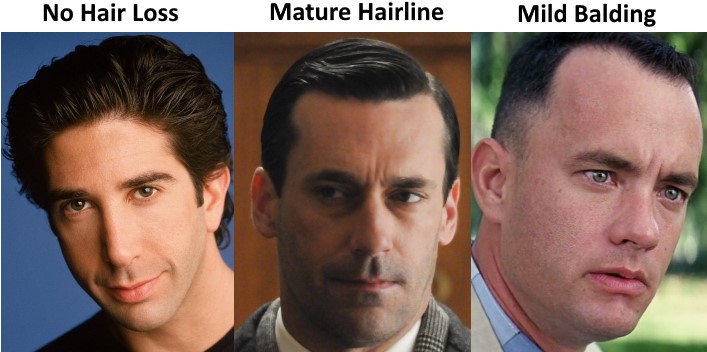
My detailed article on the mature hairline will help you determine whether or not you’re balding or simply maturing.
Type 3 – The First Stage of Balding
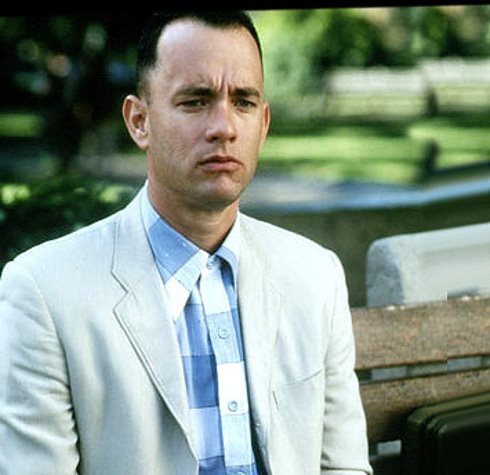
Tom Hanks has had a relatively mild type three, M-shaped receded hairline for many years. Here he in the classic ’94 film Forrest Gump.
Type three balding is generally regarded as the most common pattern of balding, but it can take on many different appearances depending on its degree of severity. Recession at the hairline corners is always observed. It can take on at least four different shapes, by my estimation, including:
1. An M-Shape – Celebrities like Jimmy Fallon, Daniel Craig, and Tom Hanks all appear to have M-shaped receding hairlines.
This early type three pattern is very common and can be inconspicuous or easily noticeable, depending on its severity.
2. A U-Shape – A U-shaped hairline is often a sign of early or very mild hair loss.
Bryan Cranston of Breaking Bad has a relatively U-shaped hairline, which has never really gotten any worse since the 1990s when he gained fame on the show Seinfeld.
When grown out, a U-shaped hairline can be completely undetectable. Canadian actor Jim Carey also has this type three hairline, as does former presidential nominee Mitt Romney. This is about as mild as hair loss gets, folks. You could even call it an advanced type two pattern. If you end up with a U-shaped type three airline, consider yourself very lucky.
3. The Extra-Large V-Shape – Sometimes the whole hairline just moves back and retains its V-shape.
If the corners of your hairline—around the edge of your eyebrow—are more than 1-1.5 inches above your highest forehead wrinkle, then you may be losing your hair, even if you still have a V-shaped hairline.
You don’t see this Norwood type III variation as often as you see the others. Conan O’Brien is one celebrity example I can think of who has a V-shaped hairline that likely goes back too far to be considered a mature hairline.
4. The “Island” of Hair – This is the most severe variety of class three balding, where the corners recede completely, leaving a prominent mass of hair, or island, in the middle of a person’s head. Former US presidents Johnson and Nixon both had this type of frontal hair loss, as does the singer Sting and the Jackass Johnny Knoxville.
Class III Vertex – Balding on the crown also occurs here.

President Nixon showed a very receded type three pattern on the Norwood scale.
The Norwood type three hairline is usually very treatable, especially of the M and U-shaped varieties. So if you read this and just realized you’re balding, that’s the good news. On this user-friendly and unbiased website, you can read about the 7 best hair loss treatment options. Moreover, you can look terrific even if your hairline is taking an upward turn, simply by using one of these 9 receding hairline styling techniques.
Type 4 – Further Recession, With a Growing Bald Spot

Judd Law has experienced a relatively “normal” hair loss progression over the last 10-15 years. He sported an M-shaped receding hairline in the early 2000s. It became more of an “island” by the mid 2000s. Now I’d say he’s at least a type 4 on the Norwood scale, perhaps even a type 5.
The difference between type three and type four balding can be fairly subtle, with more recession in the frontal hairline observed in the latter case. In type four balding, the bald spot on the vertex starts to become prominent, but there is still a solid band of hair across the mid-scalp region, which separates the frontal hairline from the vertex. I believe the singer Joey Fatone of N’Sync had a Norwood type 4 pattern, before his hair transplant with Bosley.
Type 5
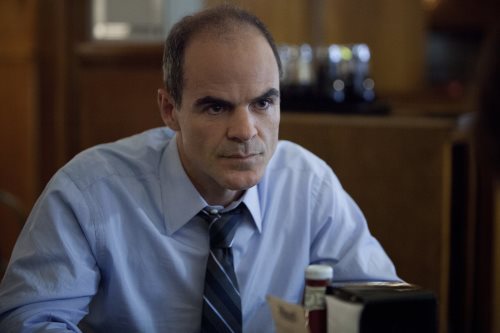
Doug Stamper from House of Cards is looking good, rocking his type five pattern with total confidence.
More bare skin is exposed on both the front and back of the head, and the bridge that separates the two balding areas starts to deteriorate. James Galdolfini, a member of my bald hall of fame, appeared to show a Norwood type 5 pattern. And he made that type 5 look awesome!
Type 6
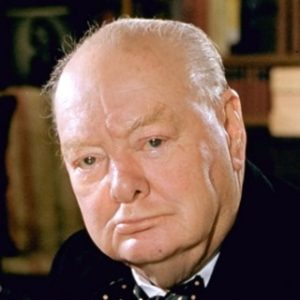
Former UK Prime minister and bald hall of fame member Winston Churchill showed a type 6 pattern. Without him, Hitler may very well have won the war.
The band between the front and rear sections of the hairline further diminishes in Norwood type VI balding. The hair on the top of the head tends to be very sparse. Prince William and comedian Louis CK both have type six patterns. It’s not uncommon for young men to show early class six patterns in their 20s, which can often only be viewed under a microscope.
Type 7 – The Full Horseshoe
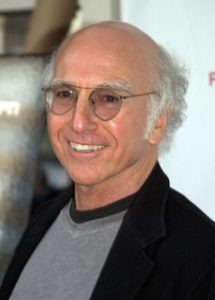
Larry David at the 2009 Tribeca Film Festival, by David Shankbone. Wikipedia Commons. LD is a prominent leader in the bald community.
This is the most severe type of hair loss. Men who develop a type seven pattern usually begin the balding process in their late teens or early 20s, although there are plenty of exceptions to this general rule. Dr. Phil, Larry David, Carl and Rob Reiner, and Steve Balmer all have type seven patterns. Larry David, by the way, is another member of my personal bald hall of fame.
Type 8 – The Undefinable

Where does Trump fit on the Norwood scale? Nowhere, as far as I can tell! Is his hair even real? You can learn more about Trump’s bizarre mane in this article, describing The Top 6 SHOCKING Facts About Donald Trump’s Hair!
About the “A” Patterns
Norwood A patterns are characterized by more frontal hair loss and have less-significant balding on the crown. “A” simply stands for anterior, meaning closer to the front. Norwood type A patterns are not nearly as common as standard patterns, accounting for fewer than 10% of hair loss diagnoses.
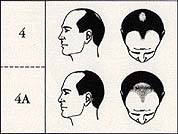
Here’s a good photo that shows the difference between Norwood 4 and Norwood 4A. You can see type 4A almost resembles a “half head of hair” with no bald spot on the crown and much more pronounced frontal hair loss.
Patterns NOT Shown on the Norwood Scale
Norwood’s scale is good but imperfect, as it’s missing a few fairly common types of hair loss, including:
DPA – Diffuse Patterned Alopecia
Many young men experience this type of hair loss, where they have thinning throughout the scalp, often in all areas except the permanent or donor zone. This type of hair loss is typically somewhat to very aggressive, but can respond well to treatments like Propecia. The end destination for diffuse thinners, in many cases, is a class 6 or 7 pattern on the Norwood scale.
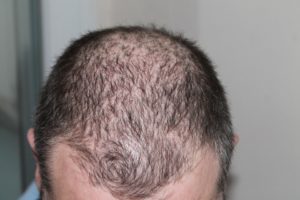
This young man is clearly experiencing diffuse thinning. Notice how his hairline is still mostly in tact, but he appears to be headed toward a Norwood 6 pattern.
DUPA – Diffuse Unpatterned Alopecia
This is a rare condition that is often misdiagnosed, as its symptoms can mirror the symptoms of regular male pattern baldness. Diffuse unpatterned alopecia indicates thinning throughout the entire scalp, including the permanent zone—that’s the horseshoe-like band you see on men with Norwood 6 and 7 patterns, which is typically resistant to DHT. DUPA is a difficult type of hair loss to treat, and DUPA patients generally make poor candidates for hair transplants. However, finasteride and minoxidil may help slow the progression of hair loss in DUPA patients.
Norwood 2V – A Normal Mature Hairline with a Bald or Thinning Spot
This pattern is actually fairly common. Some men maintain their mature hairlines but develop bald or thinning spots on their crowns.
Real-world examples include prominent figures such as Al Gore, former Vice President of the United States, along with the popular film director, Kevin Smith. You also see many older Asian men with solid hairlines up front and prominent bald spots in the back. And actually, I would say I have a Norwood 2V pattern right now, but my early thinning spot is only visible under harsh lighting–perhaps because I’ve been a dedicated minoxidil user for 1.5 years now.
Predicting the Future – How Bald Will You Be?

A fortune teller probably won’t be able to tell you how bald you’ll be. But with a miniaturization exam and a genetics overview, a hair loss specialist may be able to predict your follicular future.
Male pattern baldness or androgenic alopecia is unpredictable by nature. As I explain in my Hair Loss 101 post, pattern hair loss is an inherited trait that can come from either side of your family, or from both sides. That’s right. You could inherit your dad’s perfect hairline, and your grandpa’s prominent bald spot. Hair loss can skip generations, too—so even if everyone in your immediate family is bald, there still may be hope for you!
Now, just because your father was bald by the time he was 35, that doesn’t necessarily mean that you’re destined to share his fate. That said, if you and your father (or any close relative) both started balding around the same age, and you follow a similar hair loss trajectory over a period of time, then it’s certainly possible that you’ll end up with your father’s balding pattern.
Cases of severe hair loss—class 6 and above—usually begin to form by the time a young man reaches the age of 26, though it may take many years for his pattern to become recognizable. With a comprehensive hair miniaturization exam, hair thinning can be observed in its early stages, long before it is visible to the naked eye, and treatment can be administered if desired.
The Norwood Scale for Hair Loss – Closing Thoughts
If you just learned you’re going bald, or you’re starting to realize that you’ve lost more hair than you’d like, I have some good news for you. There are more effective hair loss treatment options available now than ever before, including FDA-approved Rogaine and Propecia.
So if you act quickly, there’s a good chance you can enjoy a full head of hair, or at least a reasonably full head of hair, for many years to come. Embracing hair loss is another perfectly viable course. Many men look good bald, and you may be one of them!
Hopefully you found out where you sit on the Norwood scale. My aim was to write the most comprehensive, user-friendly article on the subject. If I succeeded, let me know. And feel free to leave a comment or question below.
Robert Price is a writer, consumer advocate, and hair loss researcher with thousands of hours of experience in the field. His goal is to keep you out of the hair loss rabbit hole, underworld, or whatever you want to call it. He founded Hair Loss Daily, the unbiased hair loss blog, in 2016. You can learn more about Robert in the my story section of this website.
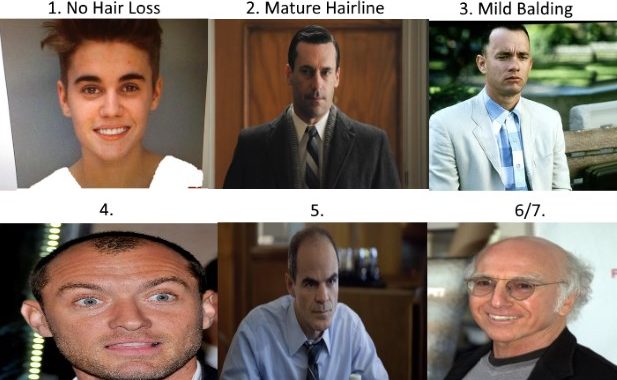
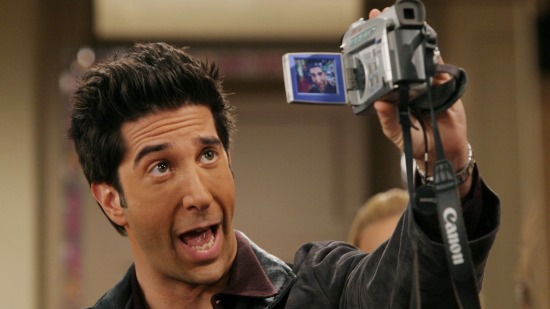

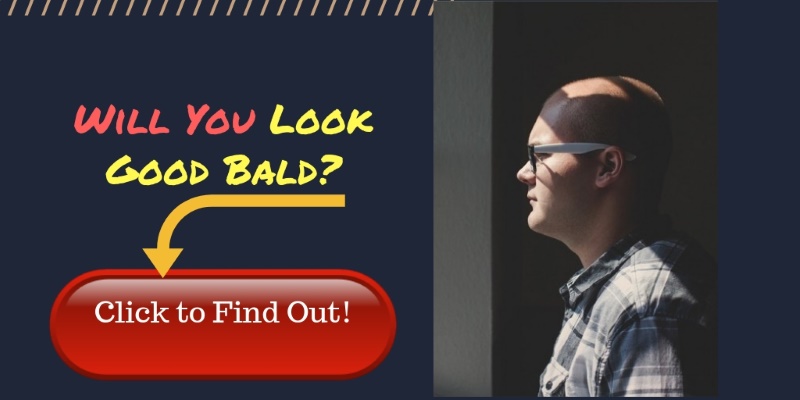

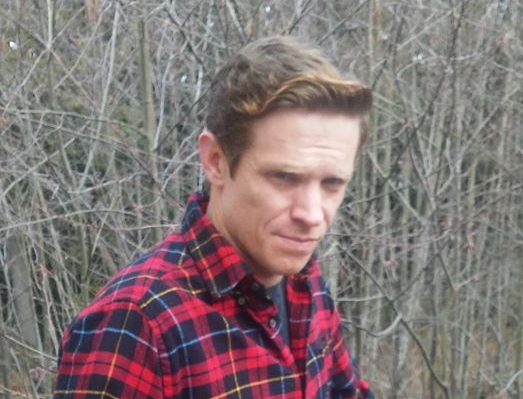
If back in my 20s a hair expert had predicted and guaranteed that I would go bald I would have been overjoyed and celebrated my prognosis. If he had told me I would have to wait until my early 50s to begin going bald, I would have been bitterly disappointed. Since I was a little boy I have had an intense desire to go male pattern bald and I didn’t want to wait until I was an old man to get my wish. I knew that it was possible to go bald very young, because several of my classmates in college were already going bald in their 20s and I was envious of them. I dreamed of marrying the girl of my dreams and then rapidly going bald immediately after our honeymoon. I did marry the girl of my dreams, but I didn’t get my male pattern baldness dream fulfilled until my 50s. Fortunately, when it finally happened, it happened fast: in less than two years. That’s not supposed to happen, right? I thought rapid balding only happened to guys who go bald in their teens or twenties. But I’m certainly not complaining, as by my 50s I couldn’t go bald fast enough. By my mid 50s I was finally Norwood 6 bald and immensely relieved. It was worth the wait, although I still wish I hadn’t had to wait. I’ve been bald nearly 20 years now and I’ve loved every minute of it. You couldn’t pay me enough to regrow my hair. I even love being teased about my baldness, and I wish it would happen more often, because I love being reminded that I am bald. I smile every time I see my bald reflection in a mirror. I love getting compliments from people who knew me before I lost my hair. They tell me I look so much better bald than when I had a full head of hair. I agree with them, of course. Most of all, I love it when my lovely wife kisses me on top of my shiny bald head. She does that quite often.
My hair loss assessment: I am incurably Norwood 6 bald and couldn’t be happier about it. It is a wish come true.
Eric – I tip my cap to you.
Any thoughts on the late Rutger Hauer’s hairline? He was Norwood 3 all his life and died at 75 still the same.
I just looked Hauer up (had never heard of him). It appears your assessment is correct. Most people who recede to a Norwood 3 early in life end up becoming fairly bald by the time they’re older, but there are always exceptions, such as former President George Bush, who retained his Norwood 3 hairline into his 90s (with no crown loss, I might add).
George Bush was amazing to keep that hair into his 90s.
The actor David McCallum is another good example as well.